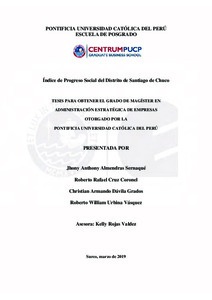| dc.contributor.advisor | Rojas Valdez, Kelly | |
| dc.contributor.author | Almendras Sernaqué, Jhony Anthony | |
| dc.contributor.author | Cruz Coronel, Roberto Rafael | |
| dc.contributor.author | Dávila Grados, Christian Armando | |
| dc.contributor.author | Urbina Vásquez, Roberto William | |
| dc.date.accessioned | 2019-03-25T21:32:04Z | |
| dc.date.available | 2019-03-25T21:32:04Z | |
| dc.date.created | 2019-03 | |
| dc.date.issued | 2019-03-25 | |
| dc.identifier.uri | http://hdl.handle.net/20.500.12404/13816 | |
| dc.description.abstract | La presente investigación, de alcance descriptivo y enfoque cuantitativo, se desarrolló
para medir el Índice de Progreso Social (IPS) del distrito de Santiago de Chuco, localizado en
la provincia que lleva el mismo nombre, dentro de la región La Libertad, en el noroeste del
Perú. El objetivo principal fue recopilar información en torno a la percepción que los
pobladores tenían ante las tres dimensiones del IPS: (a) Necesidades Humanas Básicas
(NHB), (b) Fundamentos del Bienestar (FB) y (c) Oportunidades (OP). La importancia del
IPS es que refleja la situación actual de bienestar que tiene la población, más allá de los
indicadores económicos. La población de la investigación estuvo integrada por 6,145
hogares, de los cuales se encuestó a una muestra de 303 jefes de familia, utilizando el
cuestionario estandarizado del Índice de Progreso Social (IPS), que fue creado por el Social
Progress Imperative (SPI) y adaptado para el Perú por CENTRUM Católica. De acuerdo con
los resultados obtenidos, el IPS del distrito de Santiago de Chuco asciende a 49.92, resultado
que lo posiciona en un nivel de progreso “Bajo”, inferior al de la región La Libertad y al
promedio nacional, lo que muestra inequidad en las condiciones de desarrollo que hay en el
país. En cuanto a la dimensión Necesidades Humanas Básicas, el puntaje que obtuvo el
distrito fue 56.65 por lo que se ubica en el rango “Medio bajo”; en cambio en la dimensión
Fundamentos del Bienestar, la puntuación fue 53.12, lo que se considera “Bajo”; y en la
dimensión Oportunidades, el valor medio fue 39.98 considerándose como “Muy bajo”.
Además, se encontró que la Zona 1, que corresponde al ámbito urbano tiene un IPS superior
al de la Zona 2 o rural, 55.85 versus 43.99. A partir de estos resultados, junto con los
hallazgos del análisis externo e interno, Santiago de Chuco debe desarrollar políticas y planes
para mejorar cuanto antes la seguridad personal y el acceso a la educación superior, que
fueron los componentes que registraron un menor puntaje. | es_ES |
| dc.description.abstract | The present investigation, of descriptive scope and quantitative approach, was
developed to measure the Index of Social Progress (IPS) of the district of Santiago de Chuco,
located in the province that bears the same name, within the La Libertad region, in the
northwest From Peru. The main objective was to gather information about the perception that
the inhabitants had before the three dimensions of the IPS: (a) Basic Human Needs (NHB),
(b) Fundamentals of Well-being (FB) and (c) Opportunities (OP). The importance of the IPS
is that it reflects the current welfare situation of the population, beyond the economic
indicators. The population of the investigation was composed of 6,145 households, of which
a sample of 303 heads of families was surveyed, using the standardized Social Progress Index
(IPS) questionnaire, which was created by the Social Progress Imperative (SPI) and adapted
for Peru by CENTRUM Católica. According to the results obtained, the IPS of the district of
Santiago de Chuco amounts to 49.92, a result that positions it at a “Low” level of progress,
lower than that of the La Libertad region and the national average, which shows inequity in
the conditions of development that exist in the country. Regarding the Basic Human Needs
dimension, the score obtained by the district was 56.65, so it is located in the “Medium Low”
range; however, in the Fundamentals of Welfare dimension, the score was 53.12, which is
considered “Low”; and in the Opportunities dimension, the average value was 39.98,
considered “Very low”. In addition, it was found that Zone 1, which corresponds to the urban
area, has an IPS higher than that of Zone 2 or rural, 55.85 versus 43.99. Based on these
results, together with the findings of the external and internal analysis, Santiago de Chuco
must develop policies and plans to improve personal security and access to higher education
as soon as possible, which were the components that recorded the lowest score. | es_ES |
| dc.language.iso | spa | es_ES |
| dc.publisher | Pontificia Universidad Católica del Perú | es_ES |
| dc.rights | Atribución-NoComercial-SinDerivadas 2.5 Perú | * |
| dc.rights | info:eu-repo/semantics/openAccess | es_ES |
| dc.rights.uri | http://creativecommons.org/licenses/by-nc-nd/2.5/pe/ | * |
| dc.subject | Indicadores sociales--Perú--Santiago de Chuco (La Libertad : Provincia) | es_ES |
| dc.subject | Indicadores económicos--Perú--Santiago de Chuco (La Libertad : Provincia) | es_ES |
| dc.subject | Investigación cuantitativa | es_ES |
| dc.title | Índice de progreso social del distrito de Santiago de Chuco | es_ES |
| dc.type | info:eu-repo/semantics/masterThesis | es_ES |
| thesis.degree.name | Maestro en Administración Estratégica de Empresas | es_ES |
| thesis.degree.level | Maestría | es_ES |
| thesis.degree.grantor | Pontificia Universidad Católica del Perú. CENTRUM | es_ES |
| thesis.degree.discipline | Administración Estratégica de Empresas | es_ES |
| renati.advisor.dni | 41038596 | |
| renati.advisor.orcid | https://orcid.org/0000-0002-4866-1671 | es_ES |
| renati.author.dni | 19099792 | |
| renati.author.dni | 18010739 | |
| renati.author.dni | 42189808 | |
| renati.author.dni | 09396367 | |
| renati.discipline | 413307 | es_ES |
| renati.level | https://purl.org/pe-repo/renati/level#maestro | es_ES |
| renati.type | https://purl.org/pe-repo/renati/type#tesis | es_ES |
| dc.publisher.country | PE | es_ES |
| dc.subject.ocde | https://purl.org/pe-repo/ocde/ford#5.02.04 | es_ES |






